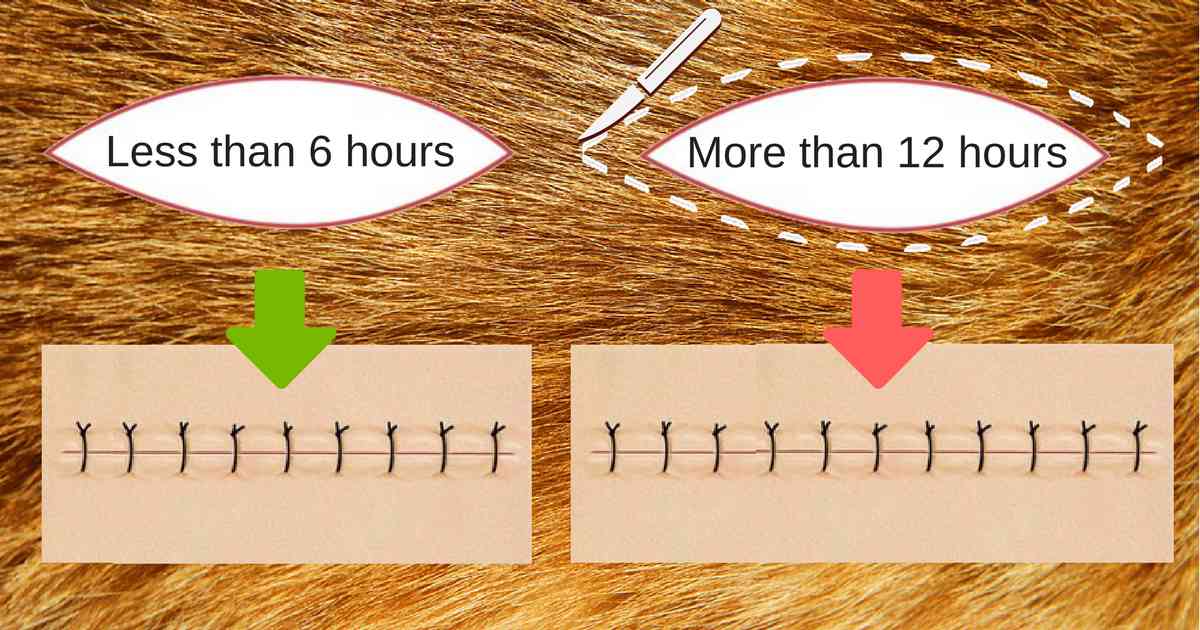Updated June 6, 2021
‘At A Glance (Details Below)’ What to do
When A Dog Or Cat Gets A Cut
- Don’t handle the wound if it looks clean, just keep your pet out of the dirt
- To remove dirt, rinse cuts in a solution of ½tsp salt to 1 cup water
- If there is serious bleeding, apply a tight bandage using clean cloth
- As long as you see a vet immediately, a tight dressing should do minimal harm and may be lifesaving
Now dive deeper…
In case you haven’t noticed yet, there are lots of things I want all pet owners to know. This week it’s a long explanation with a simple message: if you get a wound seen the same day it happens we’ll all be better off. Here’s why…
It’s The Golden Period
One of the mild disappointments I get is seeing wounds that have gone beyond when they could have been easy to manage. That timeframe is called the golden period. Usually, it’s no-one’s fault, just a lack of awareness of how quickly things change. Then, before anyone knew there was a choice, that choice has been taken away.
It’s really simple: the golden period is the time before wounds become excessively contaminated by bacteria. It’s when a vet can just give a bit of local, flush the wound, and stitch it back together. Under sedation of course.
The golden period only lasts somewhere between 6 and 12 hours. Wounds sutured during this time are easy and simple to put back together, and the pet feels very little pain or discomfort. Of course, this only applies for clean wounds like those caused by scissors, glass or sheet metal.
Will A Cut Heal By Itself?
The reason we often see wounds on dogs or cats too late is that people are wondering if they will just heal. The answer is: rarely.
Hair and fluids stick together over smaller wounds to lock in infection and prevent healing. Larger wound edges swell and separate once infection sets in. This causes wound drying and prevents a healthy granulation bed forming, which is essential for skin regrowth.
All this is complicated by a dog or cat’s natural tendency to lick at a wound. Despite the myth, licking makes wounds worse, not better.
How We Manage Other Wounds
What happens if we wait too long, or wounds are dirty?
Older Infected Cuts
If wounds become too contaminated with bacteria, dirt or hair, we have two choices:
We can remove the infected layers and then stitch the wound. This process, called debridement, needs to be performed under general anaesthetic. That’s what the diagram at the start is all about. If we don’t take out the infected layers, the wound won’t heal properly and may just open again after the stitches come out.
It’s still easy enough, but more complex and the final wound is bigger.
We can choose to manage an open wound. This is not our first choice, as it requires frequent bandage changes, takes a long time and can get quite expensive. It’s also very, very easy to do more harm than good when trying to keep bandages on a dog or cat for a long period.
Animal Bites
When a dog or cat bites another animal, it’s infected straight away. If we stitch these wounds up again all we do is just cover up the infection. Even simple animal bites often need debridement before closure, and almost all need antibiotics.
Worse things happen when a dog bites an animal much smaller than itself. These dog bite wounds often have a loose pocket under the skin that rapidly fills with toxic fluids. Patients with skin separation usually die if the correct treatment is not given.
Contaminated Wounds
Heavily contaminated wounds are common in car injuries or gunshots. A particularly severe example occurs when dogs are dragged behind a ute or car.
These wounds often require delayed closure with frequent bandage changes until the wound is healthy and clean enough to close.
The Final Message
So, yes, all these words were just a very long way of saying a stitch in time saves nine. I’ll bet you didn’t even need to be told. You were coming in straight away all along, weren’t you!
Have something to add? Comments (if open) will appear within 24 hours.
By Andrew Spanner BVSc(Hons) MVetStud, a vet in Adelaide, Australia. Meet his team here. The information provided here is not intended to be used as a substitute for going to the vet. If your pet is unwell, please seek veterinary attention.

